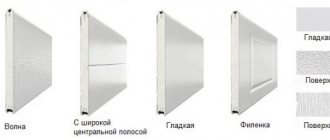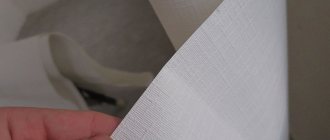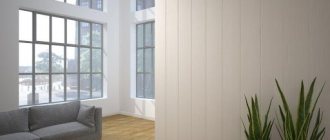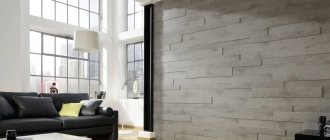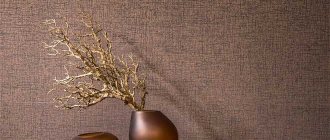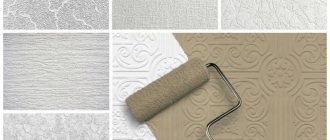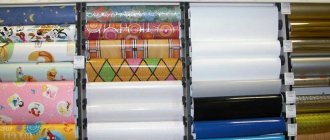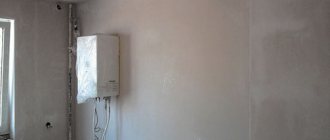PVC plastic panels are considered to be one of the most common materials for both internal and external finishing work. They are a combination of the most sought-after qualities - practicality, accessibility, high quality products. Considering the operational and installation features of such panels, they can be used for almost all types of indoor work - for cladding walls, ceilings or other interior elements, as shown in the photo.
Color options
But most often, PVC plastic panels are used for wall cladding. It is very important to know all the intricacies of this work, and it is equally important to be aware of what sizes of plastic panels for walls exist and which one should be chosen.
Square panels
Installation of plastic panels
Plastic panels are construction products made by extrusion from polyvinyl chloride. The ribs that impart rigidity are located between two thin plastic plates.
The grooves and protrusions that are equipped with the side edges of the panel are designed so that their connection with each other is invisible or included in the design composition.
Technologies for creating plastic PVC panels provide wide decorative possibilities. Using this finishing material you can imitate most natural surfaces - veneer, lining, stone, brick.
The product is available for ceilings and walls. The design is applied laminated, with thermal printing or thermal transfer, as well as with a 3D effect.
Standard parameters
The dimensions of PVC panels are selected so that they allow you to create smooth surfaces and hide their imperfections (leaks, unevenness, chips).
In addition to their decorative function, the panels have protective properties. They do not allow moisture to pass through and are sound insulators. Due to the air layers present inside, they retain heat well in the room.
Manufacturers produce building materials with a length from 0.9 to 4 m and a width of 0.1-2.03 m.
Another important parameter is the area of one panel. Knowing it, it is convenient to calculate how many pieces are needed to cover the surface. A standard size panel of 0.3*2.5 m has an area of 0.75 m².
The thickness of the product varies from 50 mm to 1 cm.
Dimensions depend on the purpose of the product. For example, a slatted panel is made 13-30 cm wide, a wall panel is up to 0.5 m, a sheet panel is up to 1.22 m, and a tiled panel is 0.98 m.
Installation of plastic panels on a metal frame
Horizontal profiles are attached to the wall using mounting plates on dowels.
- Two-feather plastic corners are inserted into the vertical and horizontal corners using self-tapping screws.
- The panels are secured with self-tapping screws through the “feather” of the lamella in the profile body. Adjacent planks are connected with a tongue-and-groove lock.
- Installation of the cladding begins from the corners, inserting the side of the first panel between the feathers of the decorative corner. The lower and upper ends of the lamellas are also inserted into the horizontal guide corner strips. For more information on how to mount panels on walls and ceilings, watch this video:
If the metal frame is installed in a room with high humidity, then horizontal gaps are created in the baseboards and pilasters of the plastic cladding. This will ensure natural ventilation of the closed space between the wall and the frame.
Properties, advantages and disadvantages
Any material used for finishing has its drawbacks. These PVC products include fragility (the panels are hollow inside) and the ability to release toxic substances upon fire.
The list of advantages will be longer:
- Long service life.
- Wide decorative possibilities. The color palette is multifaceted.
- Reasonable prices.
- Wash well with soapy water.
- Light weight per 1 m².
- High combustion temperature (almost +400˚С).
- High resistance to mold, fungi, moisture.
- The dimensions of the panels allow you to cover any area.
- Installation of the products is simple and does not require special skills.
- If damaged, the element is easily replaced.
- Good quality sound, thermal and waterproofing.
- The thermoplastic structure of polyvinyl chloride, made from salt, gas and oil, is safe (environmentally friendly) at natural temperatures. It is also used for the production of food containers, food packaging, and toys for children.
Possible sizes
Depending on the type of panels, lamellas are available in different sizes.
The lining has a length of 3 meters and a width of 10 cm. The reinforced one is slightly larger - 12.5 cm.
The dimensions of plastic panels for ceilings without seams are as follows:
- length 260, 270, 300, 400 or 600 cm;
- width - 10, 20, 25 or 50 cm.
The largest are leafy: length 150-400 and width 80-200 cm.
Peculiarities! The maximum dimensions are used for spacious premises (such as industrial facilities or garages for several cars). In ordinary apartments, plastic lining or panels no longer than 300 cm are installed.
The thickness of all products is within 5-10 mm. For a suspended ceiling, thinner ones are usually used. But you need to be careful with them - this material is less durable.
Kinds
Today there is a wide range of products made from polyvinyl chloride on the market. The material is classified depending on its purpose, size, connection method, and surface characteristics.
Tiled
It is possible to imitate different variations of ceramic tiles if you use PVC tile panels for the bathroom or kitchen.
Design solutions for PVC can contain combinations of plastic and ceramic or cover the entire wall surface. There are products on which the tiles are painted with different masonry options: standard, checkerboard, with inserts of individual elements.
PVC material is produced for tiles in sizes 98*98, 30*30, 100*100 mm.
Wall
Wall panels are produced up to 1 cm thick, from 2.7 to 4 m long and up to 0.5 m wide.
The choice of interior options that can be realized using polyvinyl chloride products is unlimited.
Manufacturers offer elements of calm monochromatic colors, bright patterns, decorated with floral designs or abstract compositions.
Wall panels with the same joints can be easily combined with each other, thus further increasing the design possibilities of the product.
Using additional elements (corners, connectors), it is easy to finish complex areas, slopes, and corners with plastic.
Leafy
For wall finishing, there is another type of finishing material - in the form of sheets, with a length of up to 4 m, a width of 50 cm to 2.3 m. Products of this type are: thin - 1 mm or thicker - 30 mm.
A distinctive feature of such PVC panels is that their dimensions allow one element to cover a large area with minimal effort, which is convenient during installation.
Sheet material imitates various embossed or smooth surfaces:
- slate;
- mosaic;
- tiles;
- brick;
- wood.
For example, only the “mosaic” PVC type is available in the following versions: Fruit, Relax, Vanilla, Turquoise, White, Terrazzo Naples, with patterns of various colors.
Lining
A stylish, aesthetic appearance of the room can be created if you use material that is made to look like lining.
Along with low maintenance, low load on the wall, complete immunity to corrosion, and 100% moisture resistance, the buyer receives a reliable, simple structure made to look like sanded wood.
The material is produced 48 mm thick, up to 30 cm wide and 0.9 to 3 m long.
The most common 2 options:
- “Polka” (with a narrow type locking system);
- Eurolining (with a standard size lock).
With 3D effect
Ceramic tiles, wood, and natural stone coated with a layer of varnish can be imitated well if you use panels with full-color 3D printing.
The interior is made using a composition of ornaments and paintings made up of 3D drawings.
An unlimited color palette, seamless structure, good heat and sound insulation qualities, but not without several drawbacks:
- the price of some types of PVC is high;
- you need to make lathing during installation, which will somewhat reduce the space of the room.
With thermal transfer
Polyvinyl chloride with thermal transfer is produced in entire collections. Technologies make it possible to apply patterns and images to polymer film quickly and efficiently. The pattern on the surface is fixed at high temperatures.
Product length – from 2.7 to 6 m, thickness – 0.8-1 cm, width – 25 cm.
The variety of patterns decorating plastic makes it possible to create an original design for a bathroom or kitchen, while simultaneously providing waterproofing, protection from mold and rot, and the absence of cracking over time.
Laminated products
The image is glued to the front part of the PVC panel so that a protective laminated layer is formed on top. It protects the pattern from damage, thereby improving the performance parameters of the product.
The PVC product is available in thicknesses up to 12 mm, length 2 m and width 25 cm.
To correctly calculate the required amount of material, you need to measure the surface area and subtract the squares for the openings for doors and windows.
The quantity per package most often depends on the thickness of the material. There are packs of 6-10 pieces. Knowing the area of one panel, it is easy to calculate how many pieces are needed.
External coating of plastic wall cladding
Basically, plastic panels are produced with three options for external coating.
Thermal film
Thermal film forms an additional moisture-proof layer.
The painted surface of the plastic is covered with thermal film. The film has an adhesive layer on the back side. The heated material is rolled with a roller, thereby ensuring a tight fit of the film to the plastic.
The decorative coating gives the panels a wide variety of colors and at the same time forms a moisture-proof layer, which also protects against minor mechanical damage.
It is recommended to cover walls with such plastic in the bathroom, toilet, and kitchen.
Direct printing method
A special printer applies patterns of various colors and halftones to the lamella. The varnished design is dried by ultraviolet irradiation.
However, the material is susceptible to moisture and can be easily scratched. Direct printed wall panels can enhance the interiors of kitchens and dining rooms.
Laminated slats
The colors and patterns of such panels are created by rolling PVC film. The strength characteristics of the dense film protect the plastic surface from minor scratches.
The use of one or another type of plastic cladding largely depends on the microclimate of the room, as well as on the economic feasibility of using this type of material. Laminated panels are perfect for bathtubs.
Types of PVC ceiling panels
PVC ceiling panels are produced in many types, sizes and shapes. They differ in design solutions, performance characteristics and installation methods.
Design features and physical properties
For PVC ceiling panels of the same size, 1 m² weighs less than for wall panels. Lightening the structure is achieved by reducing the thickness of the components. Due to the fact that there is less likelihood of mechanical damage to the plastic at the top, I make it more fragile and lighter.
To avoid unnecessary financial expenses and material waste, you need to make a calculation before purchasing.
For small rooms, such as a bathroom, it is advantageous to take the length of PVC panels for the ceiling such that they can be cut in half. If the width of the bathroom is 1.7 m, it is advisable to purchase 3.5 m plastic.
Kinds
PVC ceiling panels can be divided as follows:
- Material in the form of sheets without locks.
- Plates. Performed without connectors.
- Eurolining. Has a wide type locking system.
- "Polka". The castle is narrow.
- Lining with reinforcement. Product with double profile and width 125 mm.
- Expanded panels. They differ more in width (up to 0.5 m).
The dimensions of plastic panels for the ceiling, if they are made in the form of a sheet, reach 2 m in width and 4 m in length. Elements made to look like lining can have 1-3 sections with different designs.
Color solutions
Plastic ceiling panels are made matte or glossy. If you need to give additional depth and volume to the room, it is better to use a glossy finish.
For installation on the ceiling, white panels of varying purity are produced. But you can find colored lining or standard PVC panels of various tones.
Density
The density of the material is a necessary characteristic. An insufficient value of the parameter can lead to the fact that communications laid under the ceiling (telephone, Internet, electrical wiring) will be visible when the light is on.
Denser ceiling elements allow the installation of built-in lamps and simplify the design for a suspended ceiling - fewer crossbars are required.
Features of panels in comparison with different finishing materials
From a hygiene point of view, plastic is the best material. It is easy to clean, is not susceptible to fungus and microorganisms, and moisture does not penetrate into it. In addition, please note that:
- PVC finishing products make renovations economical. Waste during operation is minimal. A variety of sizes allows you to choose the most suitable option.
- You can cover the walls without plaster. Plastic will hide all irregularities well.
- Installation takes little time and minimal effort, and does not require special equipment.
- Wide selection of interior solutions at affordable prices.
- Large material allows you to cover large areas of the area in 1 approach.
A negative feature is that plastic is easier to damage than ceramic tiles, artificial or natural stone.
Main advantages of the material
Plastic materials owe their popularity to a number of distinctive characteristics:
- With a variety of sizes, most products are lightweight, which facilitates their installation on building structures with low load-bearing capacity. In addition, the installation of such panels does not require any complex installation systems.
- Polyvinyl chloride is a plastic and pliable material that can be processed using the simplest cutting tool. Plastic panels can be easily cut, holes can be made in them if necessary, and also adjusted to size.
- Plastic panels exhibit excellent sound insulation properties as well as thermal insulation.
- Durability of the material - PVC trim will last you at least 10 years. The reason for such a long service life is the fact that they are not subject to self-destruction, cracking and warping. Over time, they do not sag or succumb to other types of deformation.
- In addition to all the above advantages, one cannot fail to mention the possibility of creating partitions in the room using plastic panels. They will do an excellent job of dividing one large room into several smaller sectors.
Types and sizes of PVC panels
Speaking about the differences in PVC panels in size, it is worth noting that there are three standard varieties. You can also see them in the photo:
- First of all, this is PVC lining, which is rectangular panels with hollow channels inside them. The total width is usually equal to 100, 250 or 300 mm, while the thickness ranges from 6 to 10 millimeters. The length of the plastic panels is up to 6 m. They are mounted on a wooden sheathing using mounting grooves.
- Panels in the form of sheets, the front side of which is an imitation of several rows of tiles, have the following dimensions - 1220x2440x3.2 mm.
- Another type of plastic panels are individual square or rectangular tiles. The sizes of such tiles can be different - from 30x30 cm to 1x1 m.
If you decide to cladding the walls in the bathroom, then you need to select plastic panels for the bathroom, the dimensions of which will coincide with the required area. Before you start purchasing them, you need to determine how many panels will be suitable. To do this, you need to measure the area of the walls and add some reserve to it for all sorts of unforeseen situations.
After this, you need to decide how thick you would like the walls to be - the choice of type of panels depends on this. Their width can be different - from 200 to 500 mm. The thickness of plastic panels is most often 5 or 10 mm.
When purchasing plastic panels, you should definitely pay attention to the fact that each of them is absolutely flat and does not have differences, waves, dents or other defects. After all, only with the use of smooth panels is it possible to carry out high-quality installation, as well as ensure a presentable appearance with invisible joints, without shifts or distortions. In addition, it is important that all panels must be from the same batch, and also not differ in shade and color.
Recommendations for working with plastic when finishing
If the wall is flat, then the material can be attached directly to it. It makes sense to make a frame when you need to cover up old finishes (wallpaper, paint, tiles) or level a wall without plaster.
In addition, the lathing improves sound insulation, helps retain heat, and leaves space for ventilation behind the plastic.
It is economical and easy to make a base from wood. Modern antibacterial compounds contribute to the long service life of wood structures. The bars are installed parallel to the direction of the PVC panels, every 50-60 cm.
The frame is also made from U-shaped plastic profiles. Its advantage is that it is insensitive to moisture, lightweight, does not deform due to temperature changes, and is not electrically conductive.
The profile must be secured in increments of no more than 30 cm, with self-tapping screws or dowels every 0.5-1 m. To join the U-shaped parts together, cuts are made at 90˚, 45˚, 30˚. To secure the plastic, you will need clamps.
The lathing can be made from metal materials for plasterboard.
To work with panels you will need moldings:
- internal and external corners;
- joints;
- the edges; baseboards;
- finishing elements;
- F-profiles.
Living rooms
If treated with an antiseptic, then the frame in the living room can be made from wooden beams.
The premises are decorated with wood, stone, and white brick. Use decorative, laminated or mirror plastic.
One of the walls can be decorated with PVC material of other shapes. Use rectangular or square structures measuring 0.3-0.98 m, highlight the seams.
Bathroom and toilet
For a bathroom, it is better to make a frame from a galvanized profile or plastic. The material is more suitable without a relief - high humidity can cause mold or mildew, and the textured surface is difficult to clean.
Bathroom panels go well with ceramic tiles, textured plaster, or paint. The main thing is to choose the right shades. It will work out well if you alternate the width and contrast of the elements.
Prints and patterns of different colors will help you create an original design. PVC panels for the bathroom go well with a slatted ceiling, into which mirror inserts can be made.
The joints must be coated with sealant. This will prevent water from getting behind the structure and forming mold.
Technology of wall finishing with plastic panels
Installing a plastic fence directly on a wall is done in very rare cases. In any case, we do not recommend doing such work yourself. For more information on how to finish bathroom walls in one day, watch this video:
Although it should be noted that mounting plastic directly on the wall will allow you to maintain the volume of a small room without narrowing the scarce space of the room.
Attaching plastic slats to vertical fences indoors is usually carried out on a pre-prepared frame. The sheathing is made of two types: a wooden slatted lattice and a frame made of a light metal profile.
Installation of wooden sheathing
Wooden blocks are secured with dowels.
For the frame, wooden slats with a cross section of 20 x 40 mm are used. Attach the sheathing as follows:
- Make markings on the surface of the walls. In accordance with the markings, the wood is cut with a hacksaw into pieces of the required length.
- The slats are secured with dowels. To do this, use a puncher and a hammer.
- Horizontal rows of planks are placed in increments of 40 cm - 50 cm.
- They place additional rivers in places where hanging objects will be attached in the future.
- Vertical racks of the same section are placed in the outer and inner corners of the room.
Installation of a metal frame made of light profile
A wide profile is installed in the horizontal corners where the walls meet the ceiling and floor.
In the inner corners, place two racks on each adjacent side.
Do the same with external corners.
